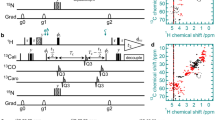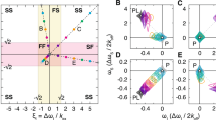Abstract
Recently, 15N-detected multidimensional NMR experiments have been introduced for the investigation of proteins. Utilization of the slow transverse relaxation of nitrogen nuclei in a 15N-TROSY experiment allowed recording of high quality spectra for high molecular weight proteins, even in the absence of deuteration. Here, we demonstrate the applicability of three 15N-detected H–N correlation experiments (TROSY, BEST-TROSY and HSQC) to RNA. With the newly established 15N-detected BEST-TROSY experiment, which proves to be the most sensitive 15N-detected H–N correlation experiment, spectra for five RNA molecules ranging in size from 5 to 100 kDa were recorded. These spectra yielded high resolution in the 15N-dimension even for larger RNAs since the increase in line width with molecular weight is more pronounced in the 1H- than in the 15N-dimension. Further, we could experimentally validate the difference in relaxation behavior of imino groups in AU and GC base pairs. Additionally, we showed that 15N-detected experiments theoretically should benefit from sensitivity and resolution advantages at higher static fields but that the latter is obscured by exchange dynamics within the RNAs.






Similar content being viewed by others
References
Adrian M, Heddi B, Phan AT (2012) NMR spectroscopy of G-quadruplexes. Methods 57:11–24
Alexandrescu AT, Loh SN, Markley JL (1990) Chemical exchange spectroscopy based on carbon-13 NMR. Applications to enzymology and protein folding. J Magn Reson 87:523–535
Alvarado LJ, Leblanc RM, Longhini AP, Keane SC, Jain N, Yildiz ZF, Tolbert BS, Souza V. M. D., Summers MF, Kreutz C, Dayie TK (2014) Regio-selective chemical-enzymatic synthesis of pyrimidine nucleotides facilitates RNA structure and dynamics studies. ChemBioChem 15:1573–1577
Bax A, Morris GA (1981) An improved method for heteronuclear chemical shift correlation by two-dimensional NMR. J Magn Reson 42:501–505
Bermel W, Bertini I, Felli IC, Piccioli M, Pierattelli R (2006a) 13C-detected protonless NMR spectroscopy of proteins in solution. Prog Nucl Magn Reson Spectrosc 48:25–45
Bhattacharya PK, Cha J, Barton JK (2002) 1H NMR determination of base-pair lifetimes in oligonucleotides containing single base mismatches. Nucleic Acids Res 30:4740–4750
Czernek J (2001) An ab Initio study of hydrogen bonding effects on the tensors in the Watson—Crick base pairs 15N and 1H chemical shielding. J Phys Chem 105:1357–1365
de la Torre JG, Huertas ML, Carrasco B. HYDRONMR (2000) Prediction of NMR relaxation of globular proteins from atomic-level structures and hydrodynamic calculations. J Magn Reson 147:138–146
Dethoff EA, Petzold K, Chugh J, Casiano-negroni A, Al-Hashimi HM (2012) Visualizing transient low-populated structures of RNA. Nature 491:724–728
Dingley AJ, Grzesiek S (1998) Direct observation of hydrogen bonds in nucleic acid base pairs by internucleotide 2JNN couplings. J Am Chem Soc 7863:714–718
Dittmer J, Kim C-H, Bodenhausen G (2003) Similarities between intra- and intermolecular hydrogen bonds in RNA kissing complexes found by means of cross-correlated relaxation. J Biomol NMR 26:259–275
Duchardt-Ferner E, Gottstein-Schmidtke SR, Weigand JE, Ohlenschläger O, Wurm J-P, Hammann C, Suess B, Wöhnert J (2016) What a difference an OH makes: conformational dynamics as the basis for the ligand specificity of the neomycin-sensing riboswitch. Angew Chem Int Ed 55:1527–1530
Fares C, Amata I, Carlomagno T (2007) 13C-detection in RNA bases: revealing structure - chemical shift relationships. J Am Chem Soc 129:15814–15823
Favier A, Brutscher B (2011) Recovering lost magnetization: polarization enhancement in biomolecular NMR. J Biomol NMR 49:9–15
Felli IC, Pierattelli R (2014) Novel methods based on proteins 13C detection to study intrinsically disordered proteins. J Magn Reson 241:115–125
Fiala R, Sklenár V (2007) 13C-detected NMR experiments for measuring chemical shifts and coupling constants in nucleic acid bases. J Biomol NMR 39:153–163
Fürtig B, Richter C, Bermel W, Schwalbe H (2004) New NMR experiments for RNA nucleobase resonance assignment and chemical shift analysis of an RNA UUCG tetraloop. J Biomol NMR 28:69–79
Fürtig B, Schnieders R, Richter C, Zetzsche H, Keyhani S, Helmling C, Kovacs H, Schwalbe H (2016) Direct 13C-detected NMR experiments for mapping and characterization of hydrogen bonds in RNA. J Biomol NMR 64:207–221
Gal M, Edmonds KA, Milbradt AG, Takeuchi K, Wagner G (2011) Speeding up direct 15N detection: hCaN 2D NMR experiment. J Biomol NMR 51:497–504
Geen H, Freeman R (1991) Band-selective radiofrequency pulses. J Magn Reson 93:93–141
Grishaev A, Yao L, Ying J, Pardi A, Bax A (2009) Chemical shift anisotropy of imino 15N nuclei in Watson—Crick base pairs from magic angle spinning liquid crystal NMR and nuclear spin relaxation. J Am Chem Soc 131:9490–9491
Grzesiek S, Bax A (1993) The Importance of not saturating H2O in protein NMR. Application to sensitivity enhancement and NOE measurements. J Am Chem Soc 115:12593–12594
Guillerez J, Lopez PJ, Proux F, Launay H, Dreyfus M (2005) A mutation in T7 RNA polymerase that facilitates promoter clearance. Proc Natl Acad Sci USA 102:5958–5963
Helmling C, Keyhani S, Sochor F, Fürtig B, Hengesbach M, Schwalbe H (2015) Rapid NMR screening of RNA secondary structure and binding. 63:67–76
Imai S, Kumar P, Hellen CUT., Souza VMD., Wagner G (2016) An accurately preorganized IRES RNA structure enables eIF4G capture for initiation of viral translation. Nat Struct Mol Biol 23:859–864
Kovacs H, Moskau D, Spraul M (2005) Cryogenically cooled probes—a leap in NMR technology. Prog Nucl Magn Reson Spectrosc 46:131–155
Leppert J, Urbinati CR, Häfner S, Ohlenschläger O, Swanson MS, Görlach M, Ramachandran R (2004) Identification of NH N hydrogen bonds by magic angle spinning solid state NMR in a double-stranded RNA associated with myotonic dystrophy. Nucleic Acids Res 32:1177–1183
Lu K, Heng X, Garyu L, Monti S, Garcia EL, Kharytonchyk S, Dorjsuren B, Kulandaivel G, Jones S, Hiremath A, Divakaruni SS, Lacotti C, Barton S, Tummillo D, Hosic A, Edme K, Albrecht S, Telesnitsky A, Summers MF (2011) NMR detection of structures in the HIV-1 5′-leader RNA that regulate genome packaging. Science 334:242–245
Noeske J, Richter C, Grundl MA, Nasiri HR, Schwalbe H, Wöhnert J (2005) An intermolecular base triple as the basis of ligand specificity and affinity in the guanine- and adenine-sensing riboswitch RNAs. Proc Natl Acad Sci 102:1372–1377
Nozinovic S, Fürtig B, Jonker HRA, Richter C, Schwalbe H (2010) High-resolution NMR structure of an RNA model system: the 14-mer cUUCGg tetraloop hairpin RNA. Nucleic Acids Res 38:683–694
Paige JS, Wu KY, Jaffrey SR (2011) RNA mimics of green fluorescent protein. Science 333:642–646
Pervushin K, Eletsky A (2003) A new strategy for backbone resonance assignment in large proteins using a MQ-HACACO experiment. J Biomol NMR 25:147–152
Pervushin K, Riek R, Wider G, Wüthrich K (1997) Attenuated T2 relaxation by mutual cancellation of dipole–dipole coupling and chemical shift anisotropy indicates an avenue to NMR structures of very large biological macromolecules in solution. Proc Natl Acad Sci 94:12366–12371
Redfield AG (1957) On the theory of relaxation processes. IBM J Res Dev 1:19–31
Reining A, Nozinovic S, Schlepckow K, Buhr F, Fürtig B, Schwalbe H (2013) Three-state mechanism couples ligand and temperature sensing in riboswitches. Nature 499:355–359
Richter C, Kovacs H, Buck J, Wacker A, Fürtig B, Bermel W, Schwalbe H (2010) 13C-direct detected NMR experiments for the sequential J-based resonance assignment of RNA oligonucleotides. J Biomol NMR 47:259–269
Rinnenthal J, Klinkert B, Narberhaus F, Schwalbe H (2010) Direct observation of the temperature-induced melting process of the Salmonella fourU RNA thermometer at base-pair resolution. Nucleic Acids Res 38:3834–3847
Rovnyak D, Hoch JC, Stern AS, Wagner G (2004) Resolution and sensitivity of high field nuclear magnetic resonance. J Biomol NMR 30:1–10
Sadek M, Brownlee RTC (1995) Study of 15N-labeled paramagnetic compunds by 15N-detected NMR experiments. J Magn Reson 109:70–75
Serber Z, Richter C, Moskau D, Bo J, Gerfin T, Marek D, Baselgia L, Laukien F, Stern AS, Hoch JC, Dötsch V (2000) New carbon-detected protein NMR experiments using CryoProbes. J Am Chem Soc 122:3554–3555
Serganov A, Yuan Y, Pikovskaya O, Polonskaia A, Malinina L, Phan AT, Hobartner C, Micura R, Breaker RR, Patel DJ (2004) Structural basis for discriminative regulation of gene expression by adenine- and guanine-sensing mRNAs. Chem Biol 11:1729–1741
Shaka AJ, Barker PB, Freeman R (1985) Computer-optimized decoupling scheme for wideband applications and low-level operation. J Magn Reson 64:547–552
Silvers R, Keller H, Schwalbe H, Hengesbach M (2015) Differential scanning fluorimetry for monitoring RNA stability. Chembiochem 16:1109–1114
Solyom Z, Schwarten M, Geist L, Konrat R, Willbold D, Brutscher B (2013) BEST-TROSY experiments for time-efficient sequential resonance assignment of large disordered proteins. J Biomol NMR 55:311–321
Stoldt M, Wöhnert J, Görlach M, Brown LR (1998) The NMR structure of Escherichia coli ribosomal protein L25 shows homology to general stress proteins and glutaminyl-tRNA synthetases. EMBO J 17:6377–6384
Stoldt M, Wöhnert J, Görlach M, Brown LR (1999) The NMR structure of the 5S rRNA E-domain–protein L25 complex shows preformed and induced recognition. EMBO J 18:6508–6521
Takeuchi K, Heffron G, Frueh DP, Wagner G (2010) Nitrogen-detected CAN and CON experiments as alternative experiments for main chain NMR resonance assignments. J Biomol NMR 47:271–282
Takeuchi K, Arthanari H, Shimada I, Wagner G (2015) Nitrogen detected TROSY at high field yields high resolution and sensitivity for protein NMR. J Biomol NMR 63:1–9
Takeuchi K, Arthanari H, Wagner G (2016a) Perspective: revisiting the field dependence of TROSY sensitivity. J Biomol NMR 66:221–225
Takeuchi K, Arthanari H, Imai M, Wagner G (2016b) Nitrogen-detected TROSY yields comparable sensitivity to proton-detected TROSY for non-deuterated, large proteins under physiological salt conditions. J Biomol NMR 64:143–151
Tanaka Y, Ono A (2008) Nitrogen-15 NMR spectroscopy of N-metallated nucleic acids: insights into N NMR parameters and N–metal bonds. Dalton Trans 37:4965–4974. doi:10.1039/b803510p
Tanaka Y, Kojima C, Morita EH, Kasai Y, Yamasaki K, Ono A, Kainosho M, Taira K (2002) Identification of the metal ion binding site on an RNA motif from hammerhead ribozymes using 15 N NMR spectroscopy. J Am Chem Soc 124:4595–4601
Walker SC, Avis JM, Conn GL (2003) General plasmids for producing RNA in vitro transcripts with homogeneous ends. Nucleic Acids Res 31:1–6
Wang W, Zhao J, Han Q, Wang G, Yang G, Anthony J, Liu J, Gaffney BL, Jones RA (2009) Modulation of RNA metal binding sites by flanking bases: 15N NMR evaluation of GC, tandem GU, and tandem GA sites. Nucleosides Nucleotides Nucleic Acids 28:424–434
Wijmenga SS, van Buuren BNM (1998) The use of NMR methods for conformational studies of nucleic acids. Prog Nucl Magn Reson Spectrosc 32:287–387
Wilusz JE, Sunwoo H, Spector DL (2009) Long noncoding RNAs: functional surprises from the RNA world. Genes Dev 23:1494–1504
Zhao B, Hansen AL, Zhang Q (2014) Characterizing slow chemical exchange in nucleic acids by carbon CEST and low spin-lock field R1p NMR spectroscopy. J Am Chem Soc 136:20–23
Ziegeler M, Cevec M, Richter C, Schwalbe H (2012) NMR studies of HAR1 RNA secondary structures reveal conformational dynamics in the human RNA. ChemBioChem 13:2100–2112
Acknowledgements
Matthias Görlach from the Core Facilities and Services (CS Protein Production) of the Fritz Lipmann Institute, Jena, is gratefully acknowledged for providing the 329 nt RNA.
Funding
This work was funded by the German funding agency (DFG) in Collaborative Research Center 902: Molecular principles of RNA-based regulation and in Graduate College: CLIC (GRK1982). Financial support by European access program (iNEXT) is gratefully acknowledged. Harald Schwalbe is member of the DFG-funded Cluster of Excellence: macromolecular complexes (EXC115). Robbin Schnieders is supported by the Fonds of the Chemical Industry. Work at BMRZ is supported by the state of Hesse. We acknowledge access to the 950 MHz spectrometer of the Astbury BioStructure Laboratory BioNMR Facility (University of Leeds) which was funded by the University of Leeds.
Author information
Authors and Affiliations
Corresponding authors
Electronic supplementary material
Below is the link to the electronic supplementary material.
Rights and permissions
About this article
Cite this article
Schnieders, R., Richter, C., Warhaut, S. et al. Evaluation of 15N-detected H–N correlation experiments on increasingly large RNAs. J Biomol NMR 69, 31–44 (2017). https://doi.org/10.1007/s10858-017-0132-7
Received:
Accepted:
Published:
Issue Date:
DOI: https://doi.org/10.1007/s10858-017-0132-7




